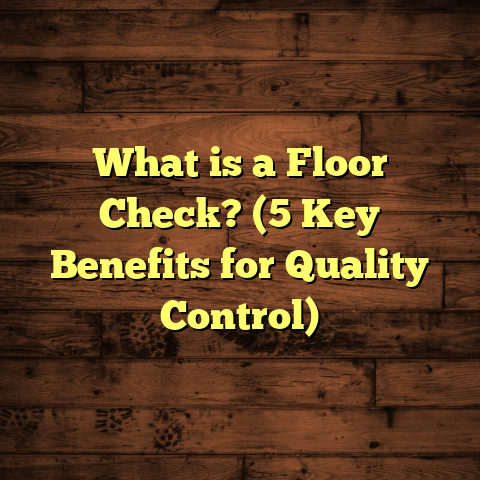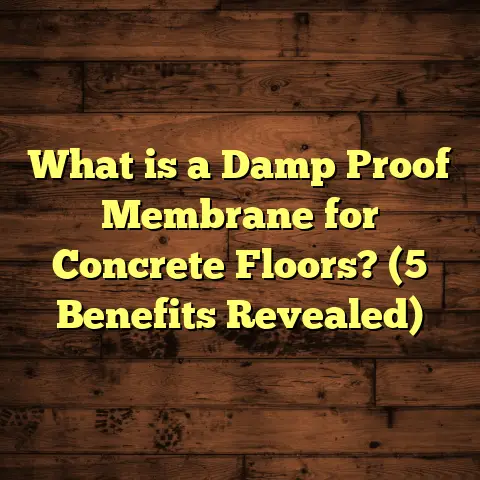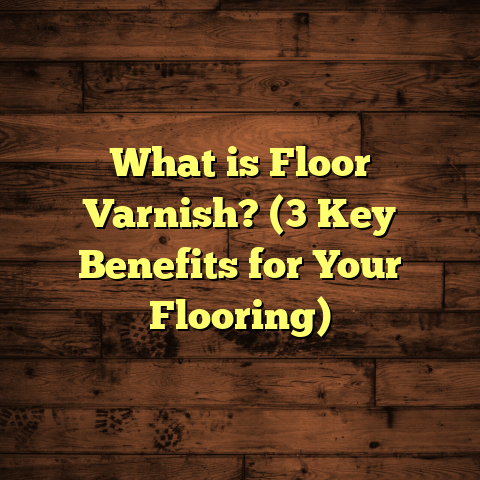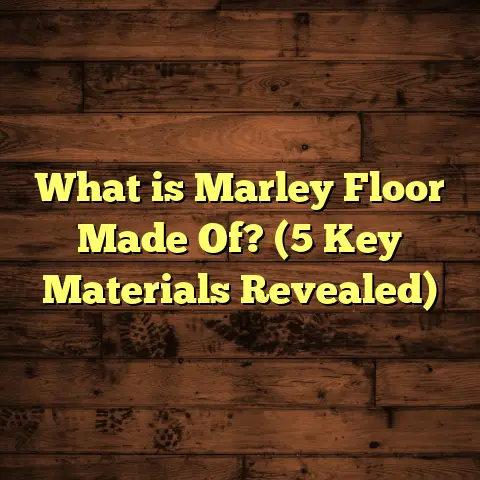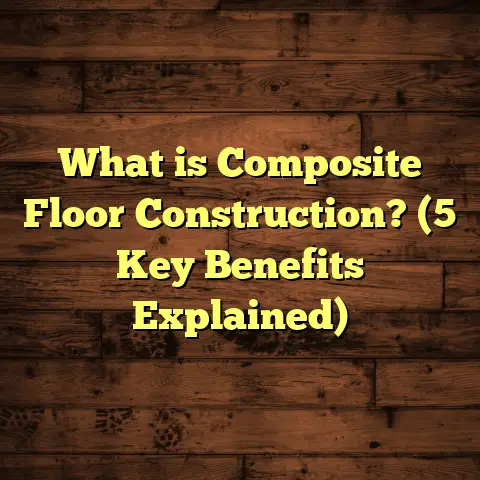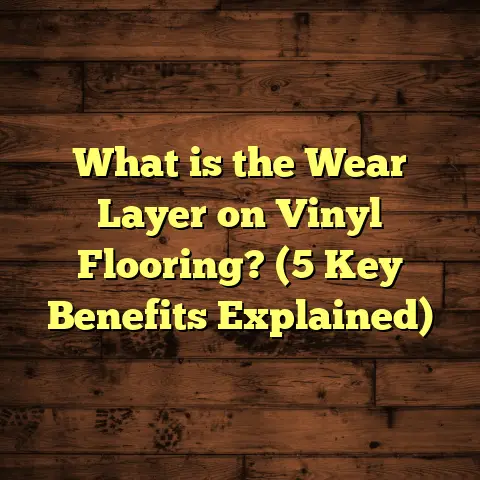What is LVT Flooring? (5 Reasons It’s the Best Choice!)
What if you could have flooring that looks just like real wood or natural stone but costs less, lasts longer, and handles spills or scratches without a second thought? Imagine a floor that feels comfortable underfoot, is easy to clean, and can be installed quickly—even in spaces where moisture is a concern. Sounds like a fantasy? It’s not. This flooring exists, and it’s called Luxury Vinyl Tile (LVT). I’ve worked in flooring for over a decade, seeing trends come and go, and LVT has truly stood out as a game-changer. Let me share why.
What is LVT Flooring?
Let’s start with the basics. LVT stands for Luxury Vinyl Tile. It’s a type of vinyl flooring designed to imitate natural materials like hardwood, stone, or ceramic tile with incredible realism. But unlike traditional vinyl sheets or lower-end vinyl planks, LVT is built with multiple layers that enhance durability, texture, and overall performance.
Anatomy of LVT Floors
Understanding what goes into LVT helps explain why it behaves the way it does. Here’s a breakdown of the typical layers you’ll find:
- Wear Layer: The topmost layer is clear and protective. Its thickness usually ranges from 6 mil (0.15 mm) for residential use up to 20 mil (0.5 mm) or more for commercial-grade products. This layer guards against scratches, stains, and general wear.
- Design Layer: Just beneath the wear layer lies the printed design layer. This is where the magic happens—the high-resolution image of wood grain, stone veining, or tile patterns is printed here. Thanks to advances in digital printing technology, these images are incredibly detailed and realistic.
- Core Layer: This is the heart of the plank or tile. It’s made from vinyl composite material (VCM) that may be enhanced with limestone fillers for strength and stability. Some products also include rigid cores made from materials like SPC (Stone Plastic Composite) or WPC (Wood Plastic Composite), which add extra durability and waterproofing.
- Backing Layer: The bottom layer provides support and helps with moisture resistance. It also aids in sound absorption and floor stability.
How is LVT Made?
The manufacturing process involves layering these components and bonding them together under heat and pressure—a process called lamination. The printed design is embossed with textures matching the visual pattern, so when you run your hand over it, you feel ridges like real wood grain or stone.
Digital printing allows manufacturers to create highly detailed designs with multiple color shades and fine textures. The wear layer is then coated with urethane or aluminum oxide to boost scratch resistance.
I remember visiting one vinyl manufacturing facility years ago. Seeing how raw materials are transformed into beautiful floor planks was fascinating—the precision in printing and embossing was on another level compared to older methods.
Why I Recommend LVT: 5 Reasons It’s a Smart Choice
1. The Look — You Won’t Believe It’s Vinyl
Years ago, vinyl flooring had a reputation for looking cheap or plastic-like. Not anymore. With current technology, LVT mimics natural materials so well it fools most people at first glance.
I had a client who wanted an elegant hardwood look but was worried about pets ruining it. We installed oak-look LVT with a subtle distressed finish—and several guests commented on how beautiful the “hardwood” floors were before learning it was vinyl.
This realism comes from both the high-resolution printed layer and embossed textures. Manufacturers use multi-layer printing to capture the complexity of natural wood grain—growth rings, knots, color variations—and embossing adds surface texture for authenticity.
2. Durability That Lasts
If you have kids, pets, or a busy household like me, durability means everything. LVT can take a beating better than many other floors.
The wear layer thickness directly correlates with durability: For residential use, 12-20 mil thickness is common; commercial floors often exceed 20 mil.
In one commercial project I did for a boutique hotel lobby (which had heavy foot traffic), we chose LVT with a 28 mil wear layer. After a year of constant guests and luggage rolling over it daily, the floor showed hardly any wear.
LVT resists scratches better than hardwood because its protective wear layer shields against dents from dropped items or pet nails. It also won’t stain easily from spills thanks to its non-porous surface.
3. Water Resistance Makes It Ideal for Wet Areas
Have you ever worried about water damage ruining your hardwood floors? LVT offers an advantage here: it’s naturally water-resistant or waterproof depending on the core type.
Unlike traditional wood that swells or warps with moisture exposure, vinyl doesn’t absorb water. This makes LVT perfect for kitchens, bathrooms, basements—even laundry rooms.
I once installed LVT in a client’s basement that had mild moisture issues in the past. Since switching to waterproof LVT planks with an SPC core, they’ve had zero problems with warping or mold growth.
4. Installation That Saves Time and Money
When I install LVT floors, I always appreciate how quick and simple it is compared to solid hardwood or natural stone tile.
There are several installation options:
- Glue-down: Adhesive secures the planks directly to the subfloor.
- Loose lay: Planks are heavy enough to stay put without glue.
- Click-lock system: Interlocking edges snap together like puzzle pieces.
Click-lock installation is my favorite for both DIYers and professionals because it’s clean, fast, and can often be done over existing floors without tearing them up.
Installation times for LVT are often 30-40% shorter than hardwood floors due to easier fitting and no sanding or finishing required after installation.
5. Affordable Without Compromising Style
Let’s talk dollars. Hardwood floors can easily run $8–15 per square foot installed; natural stone tile is often even pricier when labor is included.
LVT comes in at $2–7 per square foot installed—depending on quality and design—which makes it accessible without sacrificing appearance or durability.
In a kitchen remodel I did recently, the homeowners saved over $5,000 by choosing LVT over natural travertine tile while achieving a similar elegant look.
Technical Insights: What Sets Quality LVT Apart?
Not all LVT products are created equal. Here’s what I look for when selecting materials:
Wear Layer Thickness
A thicker wear layer means better protection from scratches and scuffs. For most residential settings, I recommend at least 12 mil; for commercial or high-traffic areas, go 20 mil or higher.
Core Construction
- Flexible Vinyl Core: Traditional vinyl composite; good for residential use but less rigid.
- SPC (Stone Plastic Composite): Rigid core mixed with limestone; very durable and waterproof.
- WPC (Wood Plastic Composite): Softer core with added foam for comfort; good sound insulation but slightly less rigid than SPC.
Embossing Techniques
Look for “embossed-in-register” textures—where embossing matches the printed design exactly—to get the most realistic feel.
Surface Coatings
Urethane coatings with aluminum oxide particles enhance scratch resistance dramatically—similar technology used in hardwood floor finishes.
A Deeper Look at Installation Methods
Glue-Down Installation
Glue-down offers strong adhesion and stability but requires clean subfloors free of dust or debris. It’s ideal for commercial settings or places where extra hold is needed.
I’ve used this method when installing floors in retail spaces where rolling carts are common.
Loose Lay Installation
Loose lay planks rely on weight and friction to stay in place—no glue needed. This method simplifies installation and makes future removal easier.
One client loved this option because they could replace damaged planks themselves without hassle.
Click-Lock Installation
Click-lock systems snap together tightly without glue or nails. It’s quick and clean—perfect for homeowners wanting minimal downtime.
I installed click-lock LVT over existing tile in a condo renovation; the entire project finished in just two days!
Maintenance Tips From My Experience
Maintaining LVT floors is straightforward:
- Sweep or vacuum regularly to remove grit.
- Use a damp mop with mild cleaner.
- Avoid abrasive scrubbers or harsh chemicals.
- Place mats at entryways to reduce dirt tracking.
- Use furniture pads to prevent indentations from legs.
I’ve seen clients keep their LVT floors looking new for years with minimal effort—much easier than refinishing hardwood every few years.
Comparing LVT With Other Flooring Types
Hardwood vs. LVT
Hardwood offers natural beauty but requires regular maintenance like sanding and refinishing. It’s vulnerable to moisture damage.
LVT gives you similar looks but is more affordable and durable against spills or scratches.
Tile vs. LVT
Tile is hard and cool underfoot but can crack if heavy objects fall on it; grout lines require cleaning and sealing regularly.
LVT provides warmth, softer feel underfoot, and easier maintenance while replicating stone looks convincingly.
Laminate vs. LVT
Laminate is less water-resistant and can swell if wet; LVT is waterproof (especially SPC cores) which makes it better for kitchens/bathrooms.
Real Data Points That Matter
- Wear Layer Durability: Industry tests show LVT wear layers with 20 mil thickness resist over 100,000 cycles of abrasion before showing wear.
- Waterproof Ratings: SPC-based LVT products have zero water absorption per ASTM D570 testing.
- Slip Resistance: Many commercial-grade LVT options meet ADA slip resistance standards with COF (Coefficient of Friction) >0.6.
- Longevity: With proper care, LVT floors last 15–20 years—sometimes longer in low traffic areas.
Case Study: Commercial Office Space Renovation
A client managing a busy office needed durable flooring that looked professional but handled high foot traffic without frequent replacement costs.
We installed commercial-grade SPC core LVT with a 28 mil wear layer featuring wood grain visuals. Installation took only four days for a 3,000 sq ft space.
After one year, the client reported zero surface damage despite daily usage by dozens of employees—saving thousands compared to replacing carpet or tile every few years.
Personal Anecdote: Why I Trust LVT
Early in my career, I was skeptical about vinyl flooring’s claims until I installed a large project in a family home with three young kids and pets. Over two years of use—including spills, dropped toys, muddy shoes—the floor looked nearly new.
That experience changed my perspective completely. Since then, recommending LVT has felt like giving clients peace of mind combined with style.
Frequently Asked Questions About LVT Flooring
Q: Is LVT suitable for radiant heating systems?
A: Yes! Most LVT products work well over radiant heating because they conduct heat efficiently without damage risks common to hardwood.
Q: Can I install LVT myself?
A: Absolutely. Many click-lock styles are DIY-friendly as long as you prepare the subfloor correctly—flat, clean, dry surfaces help ensure success.
Q: How does LVT hold up in humid climates?
A: Since vinyl doesn’t absorb moisture, it performs well in humid conditions without warping like wood floors might.
Q: What about environmental impact?
A: While vinyl is synthetic and not biodegradable, many manufacturers now offer recycling programs or use recycled content in production to reduce footprint.
Final Thoughts on Choosing Flooring That Fits Your Life
I’ve seen firsthand how choosing the right flooring affects daily living—from ease of cleaning to comfort underfoot to long-term value. Luxury Vinyl Tile combines many benefits into one package that suits modern lifestyles perfectly.
If you want floors that look beautiful, handle whatever your family throws at them, save money upfront and on upkeep—you might want to seriously consider giving LVT a chance.
Feel free to ask me anything else about product choices, installation tips, or maintenance—I’m here to help you get floors you’ll love every day!
